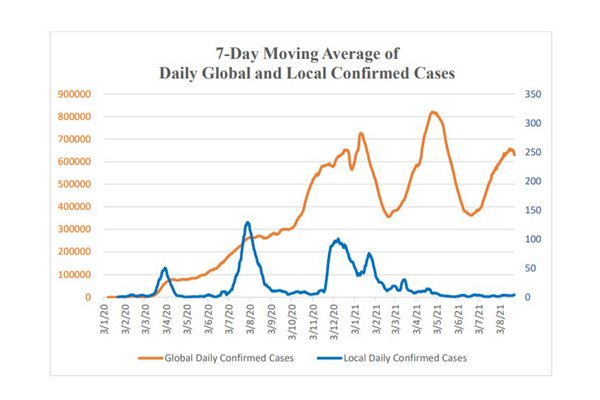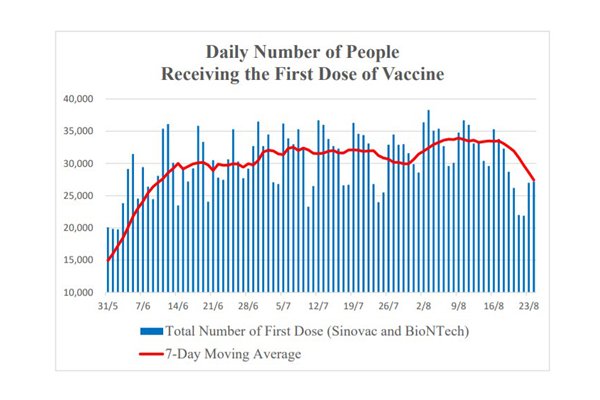Building double barriers against virus
Chief Executive Carrie Lam
The epidemic situation has remained stable in Hong Kong. Following the new direction in fighting the pandemic I announced in April, social distancing measures have been relaxed in an orderly manner. Various businesses have resumed operation and a number of large-scale events have been held successfully. People's lives are largely back to normal and our economy is showing encouraging signs of recovery. Yet, many parts of the world are facing serious challenges posed by the Delta variant and a rebound in COVID-19 cases. Some governments have no choice but to re-impose lockdown measures. In view of the prevailing epidemic situation, I proposed in early August to build double barriers for Hong Kong against COVID-19 by enhancing our measures on preventing the importation of cases to ensure that there are no loopholes, and keeping up our vaccination promotion efforts to strengthen the community's defence against the virus.
How the epidemic has developed
Over the past month, Hong Kong has only recorded two local cases with unknown sources of infection, including one which is considered a re-positive case with low transmissibility upon investigation by the Centre for Health Protection. The other one involves an airport VIP lounge worker who was believed to be infected at work by transit passengers upon investigation. In line with the cautious approach that we have adopted all along, we have taken strict compulsory quarantine and testing measures for the close contacts of the confirmed cases and the places visited by the infected. More than 20 days have passed and no further case has been found. We therefore believe that the possibility of community infection is extremely low. Overall speaking, we have kept the imported virus away from the community and succeeded in sustaining zero infection.
However, when we look at other places, the rampant spread of the Delta variant has caused a continuous rise in the global number of confirmed cases since June. A new wave of the epidemic has apparently set in and the situation is worrying. Meanwhile, the Mainland has to step up its anti-epidemic efforts in response to the emergence of sporadic local case clusters in several provinces and municipalities.
Anti-epidemic efforts
The success of Hong Kong's anti-epidemic efforts does not come by easily and members of the public deeply cherish the return to normal life. We therefore should not be complacent and must not let our guard down. I proposed to build double barriers against COVID-19, that is, building a strong wall of defence to prevent the importation of cases into Hong Kong and a protective shield for the community through vaccination. Regarding the prevention of importation of cases, in view of the volatile global epidemic situation, we have re-categorised overseas places more systematically into high, medium and low risk and implemented quarantine requirements according to the risk level. At the same time, we have strengthened every step from the arrival of the travellers in Hong Kong to their completion of quarantine so as to ensure that there are no loopholes. As for building an immunity barrier through vaccination, we have taken multiple measures to boost our vaccination rate, which include extending the requirement of getting vaccinated or undergoing regular testing at own expenses to cover all government employees, staff members of the Hospital Authority, school teachers and staff, etc, and expanding the same-day ticket arrangement at community vaccination centres (CVCs).
The major measures introduced are set out below chronologically:
|
Date |
Event |
|
August 2 |
The Chief Executive chaired a press conference to highlight the need for Hong Kong to build double barriers by strengthening measures on preventing importation of cases and raising vaccination rate as soon as possible. |
|
August 4 and 5 |
The Government suspended quarantine exemption under the Return2hk Scheme for persons returning from Mainland areas other than Guangdong Province and Macau. |
|
August 5 |
The Government's outreach vaccination team provided for the first time a vaccination walk-in service at a temporary vaccination area set up in a shopping mall. |
|
August 6 |
The Government announced that the operation of 26 CVCs would be extended by one month. The CVCs would continue to provide vaccination services for the first dose in September. Provision of school outreach vaccination service as well as group booking service for primary and secondary schools would also be extended by one month accordingly. |
|
August 9 |
Overseas places were re-categorised into high-risk, medium-risk and low-risk groups, and boarding, quarantine and testing requirements would be implemented based on risk levels. |
|
August 11 |
The same-day ticket arrangement introduced in late July at 24 CVCs (except those run by private hospitals) was expanded to cover persons aged 60 or above, and further expanded to cover students aged 12 or above with effect from August 27. |
|
August 20 |
The Government tightened the quarantine requirements for persons arriving from 16 overseas places, requiring them to be subject to 21 days of compulsory quarantine. For travellers arriving at Hong Kong from medium-risk places, their compulsory quarantine period can be shortened from 21 days to 14 days if they hold a recognised vaccination record. |
|
August 26 |
The Government announced the conclusion of bilateral vaccination record recognition agreements with the governments of Indonesia and the Philippines under which foreign domestic helpers who have been fully vaccinated in the two countries can come to work in Hong Kong starting from August 30, and they are required to undergo compulsory quarantine in a designated quarantine facility after arriving in Hong Kong. |
|
September 1 |
The Government strengthened the vaccination in lieu of regular testing arrangement. All government employees as well as all staff members of the Hospital Authority, kindergartens, primary schools, secondary schools, tutorial schools, residential care homes for the elderly, residential care homes for persons with disabilities and nursing homes who cannot produce a relevant medical certificate are required to have received at least their first dose of vaccine while those who are unfit for vaccination because of medical conditions are required to undergo regular COVID-19 tests. |
Striking a balance in light of changing circumstances
Over the past month, some residents had understandably some grievances against the stringent anti-epidemic measures taken by the Government to prevent the importation of cases. They considered that given the epidemic situation in Hong Kong has been under control, the measures are too stringent, bringing inconvenience to people who need to do cross-boundary travel and even undermining Hong Kong's status as an international financial and commercial centre. I hope members of the public would appreciate that, to keep up the good momentum of zero local infection to enable members of the public to resume normal lives on the whole, we must prevent the importation of the virus in tandem. Amid the resurgence of the epidemic around the world, Hong Kong has successfully suppressed the disease and prevented a rebound, maintaining the normal operation of society at large. For example, the Economist has compiled a normalcy index measuring the extent to which normal lives are maintained amid the epidemic in 50 economies around the world based on the living situation of residents in such areas as work, shopping, entertainment and travel, with Hong Kong topping the index. In the face of the volatile global epidemic situation, the Government has to make a timely response, which may inevitably bring inconvenience to Hong Kong residents. I appeal for the public's understanding on this.
Vaccination
While it is difficult to predict the prevalence of mutant strains and the epidemic situation in other places, we can certainly raise the vaccination rate to enhance the capability of Hong Kong to fight the virus, so that even if there is any breakthrough case, it would not spread widely in the community. Different experts may hold different views on how to achieve herd immunity, yet it is without doubt that the higher the vaccination rate, the better. Since the launch of the Early Vaccination for All campaign in late May, the vaccination rate has clearly been increasing with the support of the business sector and organisations. More than four million people have received their first dose of vaccine to date, accounting for over 60% of the population eligible for vaccination. Nevertheless, the current vaccination rate is not sufficient to provide adequate protection to the community, and I also notice that the increase in the vaccination rate has slowed down in recent days.
At present, most members of the public have been vaccinated. There is no reason for anybody to worry about the safety of the vaccines. Experts have also repeatedly emphasised that vaccines can still provide effective protection against the mutant virus, especially in preventing serious illnesses. For members of the public who are still hesitant, I strongly urge them to get vaccinated immediately. Employers of enterprises should also request all their employees to receive vaccination. I hope that with the support of members of the public, we can build a vaccine barrier as soon as possible to allow our lives to resume normal.
Chief Executive Carrie Lam issued this article titled Building Double Barriers Against COVID-19 on August 27.

